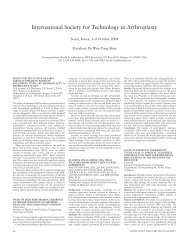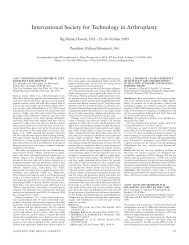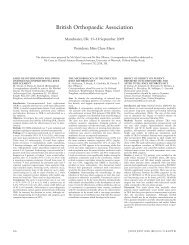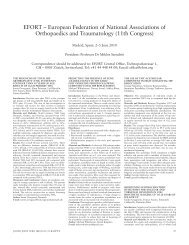Procs III 2011.indb - Journal of Bone & Joint Surgery, British Volume ...
Procs III 2011.indb - Journal of Bone & Joint Surgery, British Volume ...
Procs III 2011.indb - Journal of Bone & Joint Surgery, British Volume ...
Create successful ePaper yourself
Turn your PDF publications into a flip-book with our unique Google optimized e-Paper software.
364 HELLENIC ASSOCIATION OF ORTHOPAEDIC SURGERY AND TRAUMATOLOGY<br />
125 INTRAMEDULLARY NAILING OF<br />
COMBINED / EXTENDED FRACTURES OF<br />
THE HUMERAL HEAD AND SHAFT<br />
C.Garnavos, N.Lasanianos, V.Lakka. M.Morakis,<br />
G.Sinnis, K.Papagiannakos<br />
1st & 2nd Trauma & Orthopedic surgery dept.<br />
Athens General Infirmary “Evaggelismos”<br />
Although intramedullary nail fi xation maybe highly<br />
indicated for comminuted and segmental humeral fractures<br />
that require operative treatment, the literature<br />
lacks reviews <strong>of</strong> this content.<br />
The aim <strong>of</strong> the present study is to prospectively evaluate<br />
the clinical and radiographic outcomes in patients<br />
with combined head and shaft fractures <strong>of</strong> the humerus<br />
who were treated by antegrade locking intramedullary<br />
nailing.<br />
During a period <strong>of</strong> four years 21 patients (9 men &<br />
12 women) between 36 and 82 years old, with combined<br />
fractures <strong>of</strong> the humeral head and shaft, were operated<br />
by one surgeon. Three types <strong>of</strong> nail implants were used<br />
(Polarus long, Garnavos nail, True fl ex nail) and antegrade<br />
technique was performed in all cases.<br />
The mean operating time was 105 min (50’-140’).<br />
The period <strong>of</strong> follow-up averaged 14.25 months (range,<br />
9 to 18 months). Two patients were lost to follow up<br />
and one died before the callus formation procedure<br />
was accomplished. The functional assessment included<br />
determination <strong>of</strong> the Constant score and documentation<br />
<strong>of</strong> shoulder function as compared with the non injured<br />
extremity. Radiographic control was obtained during<br />
the follow-up intervals and at the fi nal follow up. No<br />
neurovascular complications, deep wound infections or<br />
non-unions were recorded and all fractures were fully<br />
healed between 4 to 8 months post-operatively. In one<br />
case the nail was extracted before callus formation was<br />
achieved, because <strong>of</strong> acromion impingement.<br />
The results are judged as very satisfying, taking into<br />
account the comminution <strong>of</strong> the fractures. Further evaluation<br />
<strong>of</strong> the results, with comparable methods <strong>of</strong> internal<br />
fi xation <strong>of</strong> such fracture patterns, is needed.<br />
126 ARTHROSCOPICALLY ASSISTED<br />
REDUCTION AND INTERNAL FIXATION OF<br />
TIBIAL PLATEAU FRACTURES<br />
S.Plessas, D. Louverdis,P. Mavroeidis,A.<br />
Bourlekas,G. Stroboulas,N. Prevezas<br />
Orthopaedic Dpt.<strong>of</strong> General Hospital Nikaia<br />
Peirea<br />
During the last few years, the arthroscopically assisted<br />
technique for reduction and internal fi xation <strong>of</strong> tibial<br />
plateau fractures is <strong>of</strong> increasing popularity. The accumulated<br />
surgical experience allowed the possibility <strong>of</strong> treating<br />
type I, II, <strong>III</strong> according to Schatzker classifi cation.<br />
During the last two years 17 patients who had suffered<br />
a tibial plateau fracture were treated this way.<br />
The mean age was 44 years, while the mean FU was<br />
16 months. According to Schatzker classifi cation 8 fractures<br />
were type I, 6 fractures type II and 3 fractures type<br />
<strong>III</strong>. The bone reduction was achieved under arthroscopic<br />
view and fl ouroscopy. In all cases the fracture was fi xed<br />
by the with cannulated Herbert type screws. Meniscal<br />
lesions were fi xed in 9 patients, while in 5 patients<br />
ruptures <strong>of</strong> the ACL were detected, which were reconstructed<br />
at a later stage.<br />
Full range <strong>of</strong> motion <strong>of</strong> the knee was restored in 11<br />
patients, while lack <strong>of</strong> full knee fl exion (mean 100) was<br />
found in 6 patients. All patients were assessed with a<br />
modifi ed Lyslom Knee Scale. The Knee score was 85<br />
points to 96 points (mean 92 points), while the anterior<br />
knee pain was the common problem especially following<br />
increased activities.<br />
The proposed arthroscopically assisted technique<br />
for reduction and fi xation <strong>of</strong> certain types <strong>of</strong> tibial plateau<br />
fractures consists a alternative minimal invasive<br />
approach. Visualization <strong>of</strong> the whole joint is possible<br />
and concomitant lesions can be detected and possibly<br />
fi xed at the same time<br />
127 A TWO STAGES TREATMENT OF HIGH<br />
ENERGY FRACTURES OF DISTAL TIBIA.<br />
RESULTS ESTIMATION.<br />
G. Antypas, Ath. Konstas, G. Kontogiannis, K.<br />
Liossis, P. Gakis, N. Prevezas<br />
Orthopaedic Department, Nikaia, Piraeus General<br />
Hospital “Ag. Panteleimon”<br />
The treatment <strong>of</strong> high energy fractures <strong>of</strong> distal tibia by<br />
internal fi xation is followed by a high rate <strong>of</strong> s<strong>of</strong>t tissue<br />
complications.<br />
The result estimation <strong>of</strong> these fractures in a two stage<br />
treatment, bridging the ankle by Ex-Fix with/without<br />
internal fi xation <strong>of</strong> the fi bula and internal fi xation <strong>of</strong> the<br />
tibia after s<strong>of</strong>t tissue recovery<br />
In a 4 year period (2005-8), 15 patients, average <strong>of</strong> 42<br />
years were treated. The AO fracture classifi cation was<br />
followed. The s<strong>of</strong>t tissue damage estimation (Osternn-<br />
Tscherne and Gustillo classifi cation), the fracture pattern<br />
<strong>of</strong> the fi bula and the injury mechanism consisted <strong>of</strong><br />
the choice method criteria. The majority <strong>of</strong> the injuries<br />
was classifi ed Tscherne II & <strong>III</strong>, and 3 open fractures<br />
Gustillo II. Fracture reduction was performed by bridging<br />
Ex-Fix <strong>of</strong> the ankle with/without plating the fi bula<br />
with a 1/3 or DCP 3.5 mm plate. Defi nite internal fi xation<br />
<strong>of</strong> the tibia by locking plate was performed from<br />
8th -14th postoperative day after s<strong>of</strong>t tissue recovery.<br />
Preoperatively CT scan was performed with grate signifi<br />
cance, defi ning the s<strong>of</strong>t tissue condition, the surgical<br />
approach and the osteosynthesis type.<br />
Follow up average 14 months. None <strong>of</strong> the patients<br />
developed infection. All wounds were healed in one<br />
stage. Superfi cial skin necrosis was conservatively<br />
treated in two patients.<br />
S<strong>of</strong>t tissue complications, after internal fi xation <strong>of</strong><br />
high energy fractures <strong>of</strong> the distal tibial, usually appear.<br />
Two stages treatment allows better preoperative planning,<br />
immediate patient mobilization and reduce complication<br />
rate<br />
128 TREATMENT OF COMPLEX TIBIAL<br />
SHAFT FRACTURES USING ILIZAROV<br />
EXTERNAL FIXATION<br />
M. Beltsios, O. Savvidou, E. Papavasiliou G.<br />
Giourmetakis, A. Kaspiris, J. Mpesiris<br />
Orthopaedic Department, General Hospital <strong>of</strong><br />
Elefsis, «Thriassio» Athens, Greece<br />
The frequent choice <strong>of</strong> treatment for tibial shaft fractures<br />
is intramedullary nailing. However there are cases<br />
where this treatment is problematic and alternative<br />
treatments are chosen with satisfi ed results.<br />
Twenty-nine patients with complex, unstable tibial<br />
shaft fractures (13 males and 16 females) aged 18 to 76<br />
years (mean age 49 years) were treated using Ilizarov<br />
external fi xation, the last decade in our Department by<br />
the same surgeon. The indications were open Gustillo<br />
<strong>III</strong> fractures, comminuted fractures <strong>of</strong> the proximal or<br />
distal third tibia near metaphysis, concomitant plateau<br />
or pillon fractures and fractures after total knee arthroplasty<br />
(TKA). All frames were applied the fi rst day <strong>of</strong><br />
injury. Patients without concomitant intraarticular<br />
fracture or bone defi cit allowed to full weight bearing<br />
within2 weeks after surgery.<br />
Union and good to excellent alignment with full range<br />
<strong>of</strong> motion in the knee and ankle joints was obtained<br />
in all patients. Three patients needed bone lengthening<br />
using the initial applied frame after corticotomy in<br />
second operation. There were 7 delayed unions in fractures<br />
without bone defi cit, 10 superfi cial pin tract infection<br />
treated with antibiotics and local care and 1 deep<br />
infection which needed surgical intervention.<br />
Ilizarov external fi xation gives the solution in diffi cult<br />
and problematic tibial shaft fractures and allows early<br />
weight bearing<br />
129 CIRCULAR EXTERNAL FIXATION<br />
AND CLOSED REDUCTION FOR THE<br />
TREATMENT OF TIBIAL PLATEAU<br />
FRACTURES<br />
M. Beltsios, O. Savvidou, G. Giourmetakis, E.<br />
Papavasiliou, J. Dimoulias,<br />
Orthopaedic Department, General Hospital <strong>of</strong><br />
Elefsis «Thriassio» Athens, Greece<br />
Treatment <strong>of</strong> tibial plateau fractures Schatzker type V and<br />
VI or with s<strong>of</strong>t tissues injuries is still remains under discussion.<br />
The purpose <strong>of</strong> this study is to evaluate the results <strong>of</strong><br />
treatment with circular frame and closed reduction in 25<br />
patients (15 males and 10 females) with tibial plateau fractures,<br />
with a mean age <strong>of</strong> 42 years old (20 – 76 years).<br />
Five fractures were classifi ed as Schatzker type II and<br />
<strong>III</strong> and 20 as type V and VI. Reduction was obtained in<br />
22 cases under foot traction and in 3 arthroscopically.<br />
<strong>Bone</strong> grafts inserted through a hole (≤ 1 cm) in the inner<br />
cortex <strong>of</strong> the tibia metaphysis under fl uoroscopy. Eight<br />
unstable knees needed bridging the joint for 4 weeks. In<br />
2 cases a cannulated interfragmentary screw was used.<br />
Full weight bearing was allowed 3 months after injury<br />
when the device was removed.<br />
Follow up ranged from 1 to 10 years (mean 5 years).<br />
All fractures were united and there was no infection.<br />
Full range <strong>of</strong> the knee motion was achieved in 23<br />
patients while 2 needed an open arthrolysis. There were<br />
2 malunions which were treated with one valgus osteotomy<br />
and one TKR. Asymptomatic arthritis appeared<br />
in 6 patients. According to Knee Society Score (KSS) the<br />
results were classifi ed as excellent in 12, good in 8, fair<br />
in 3 and poor in 2 patients.<br />
Circular frames are a satisfactory alternative method<br />
for the treatment <strong>of</strong> tibial plateau fractures either in<br />
severe s<strong>of</strong>t tissues injuries or in very complex cases<br />
130 TREATMENT OF OPEN TIBIA SHAFT<br />
FRACTURES WITH SIMULTANEOUS<br />
EXTERNAL FIXATION AND ALLOGRAFT<br />
APPLICATION<br />
I. Nikolopoulos, S. Kalos, G. Krinas, D.<br />
Kypriadis, A. Elias, G. Skouteris<br />
2nd Orthopaedic Department G.H. “Asclepeion<br />
Voulas”<br />
The use <strong>of</strong> external fi xation in open tibia fractures with<br />
severe s<strong>of</strong>t tissue injury is the most preferred and safe<br />
treatment. The primary allograft application is doubtful<br />
due to high infection risk.<br />
The evaluation <strong>of</strong> the results <strong>of</strong> open tibia fractures<br />
type II and <strong>III</strong> according Gustillo-Anderson that were<br />
treated with simultaneous external fi xation and allograft<br />
application.<br />
From 2005-2007, twenty nine open tibia shaft fractures<br />
in 27 patients (2 bilateral) with mean age <strong>of</strong> 35<br />
years-old were treated.<br />
According Gustillo-Anderson classifi cation, there<br />
were 20 GII, 6G<strong>III</strong>a and 3G<strong>III</strong>b open tibia shaft fractures<br />
without severe bone loss. All patients were treated<br />
with thorough and extensive surgical debridment, external<br />
fi xation and simultaneous application <strong>of</strong> allograft<br />
and double antibiotic scheme. The patients were followed<br />
up initially weekly till stitches removal and every<br />
second week till the external fi xation removal without<br />
developing any signs <strong>of</strong> infection.<br />
Overall, there were uncomplicated union in 23 cases<br />
(18 GII, 3G<strong>III</strong>a and 2G<strong>III</strong>b) whereas in 5 cases we had<br />
to change method <strong>of</strong> treatment (3 GII and 2G<strong>III</strong>a) due<br />
to union delay or non acceptable fracture angulations.<br />
There were also a case that developed deep infection<br />
and septic pseudarthrosis.<br />
The simultaneous external fi xation and allograft<br />
application seems to provide a small advantage in open<br />
fracture consolidation despite the established wisdom<br />
for allograft use on a later stage. The proper initial<br />
open fracture estimation, the right surgical treatment,<br />
the surgeon’s experience and a strict patient’s follow up<br />
schedule are fundamental for a good fi nal outcome<br />
J BONE JOINT SURG [BR] 2011; 93-B:SUPP <strong>III</strong>








